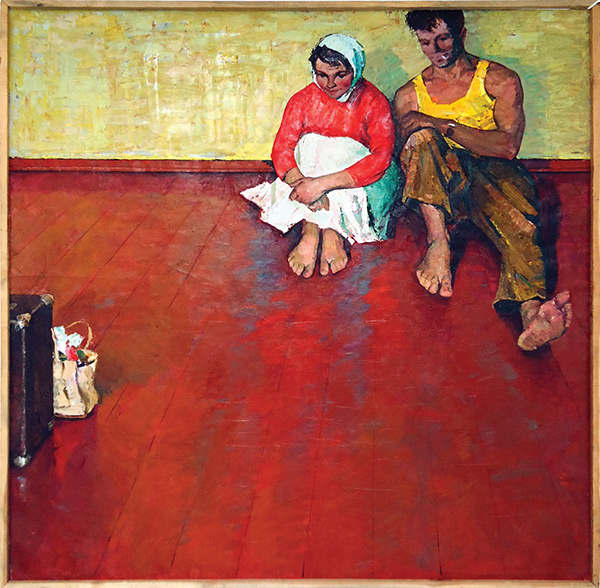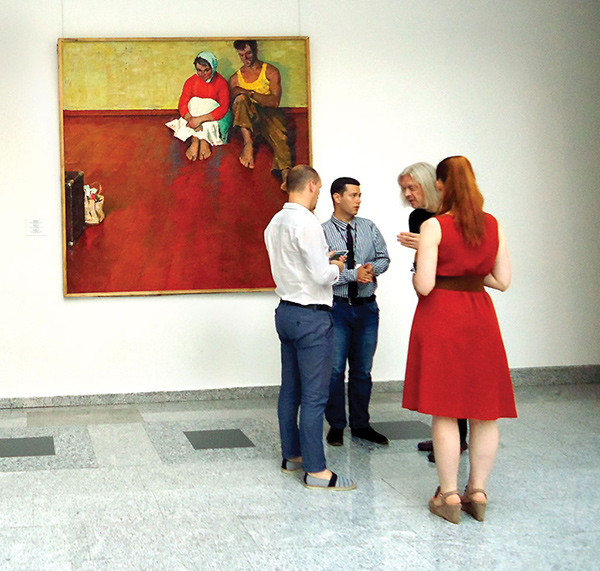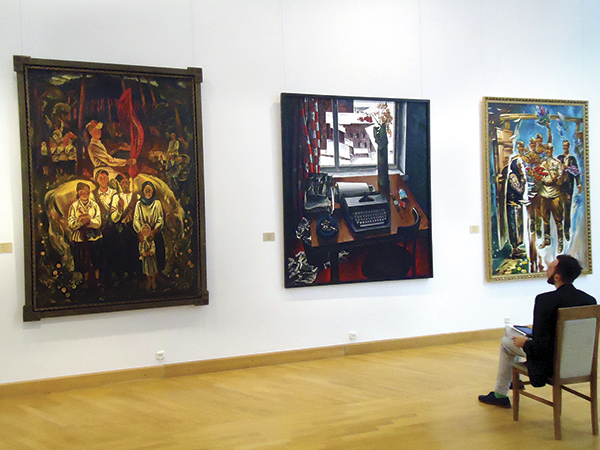
New Tenants by Mai Dantsig
Of all Mai Dantsig’s pictures kept at the National Art Museum, this one perhaps radiates the most optimism and warmth. It shows a couple, most likely spouses, sitting on the freshly painted floor of an empty home, with their suitcases, newly moved in: a simple formula for happiness. The picture was painted in 1962, when city-planning reforms were in full sway, but the theme continues to resonate today.
The ‘new tenants’ theme was popular in post-war art, with fine art often reflecting happy moments relating to Soviet families’ obtaining a home. Artworks reflected the state’s mission of addressing the housing problem, when apartments were urgent needed, and the process of accelerated urbanisation and, consequently, housing construction growth.
Mai Dantsig’s New Tenants was created during this time, in 1962. The young painter, fresh from Moscow Institute named after Surikov, found an absolutely original approach to conveying the theme, avoiding details typical of sentimental painting in the 1950s, such as fig plants, wardrobes, and bookshelves. Rather, Mai opted for simple plots and compositions.
A young couple are sitting in their new flat, still empty, on a floor freshly painted in red. There is no furniture — no table, no chairs, just bare walls. The newly weds’ only company is their suitcases, modestly standing in the opposite corner of the room. The empty space and two persons make the painting timeless: all that is depicted has always existed and will always exist. We see the emotions of joy for those first entering their new, beautiful, well-built home.
The painting, resembling a film scene, has a simple plot. However, the attentive viewer will be able to imagine the coming days, of hopes for a future life. You can almost hear tired steps on the staircase, the sound of hammer and drill (so irritating for neighbours), the clink of celebratory glasses at the housewarming party, the laughter and cries of growing children, or maybe even grandchildren… A whole existential rainbow can be sensed in the picture — since life, youth and love lie ahead.
A monumental and expressive artist, Mai Dantsig chose an unusual and ultramodern composition for a simple, routine scene. The characters are placed off-centre, in the upper right corner, with the floor occupying the major part of the painting. Thus, the figures (painted almost to full size) are perceived as being on the verge of reality, looking in at what lies ahead. May conveys a vivid, captured moment, in part thanks to choosing red (a traditional favourite of the artist) as the dominating colour, while blinding white and bright yellow spots add to the resonance of the painting.

Single painting exhibition
Notably, the artist’s innovative minimalism was not well-received at the time. He recollects, “When representatives of the exhibition committee saw my painting, they had it immediately removed from the exhibition. I was accused of libeling Soviet reality. They asked, ‘Where have you seen barefoot people with no belongings who look upset?’ They wanted to withdraw my work.”
The artist’s talent showed itself not only through art, but in his ability to quickly solve challenging tasks. Within a night, Mr. Dantsig had ‘polished up’ his picture, adding a pair of women’s patent-leather shoes; the next day, his artwork passed censorship. However, later, the artist painted out the shoes, restoring the initial version. Still, the painting received positive reviews. New Tenants made Mai famous for many years, as the canvas was displayed at the All-Union Art Exhibition, in Moscow, immediately after being created.
Mr. Dantsig’s creative path then took another interesting turn in portraying a frank vision of the time and its people. In the Plant Canteen synthesised his impression of the virgin lands. “What I saw there, in the virgin lands, enthralled me so much that I thought it was absolutely impossible to stay for just one month, as I’d initially intended. I stayed for three months, but even that term still seemed insufficient for serious, real work,” he recollected.
The painting was displayed at an exhibition in Minsk, in 1963. It reflected his interest in people who ‘build’ their future. It was a major theme for many years in Dantsig’s art, bringing forth Towards a New Life (1958, a diploma work), New Blocks Growing (1960), Old and New Minsk (1960), and Minsk Awakening (1960). Incredibly poetic, they reflect hope for the future, as was typical of that time and the author’s desire to depict the ‘common hero’. Created at the same time as New Tenants, these are self-portraits in their essence and, in combination with other documents, offer a complete ‘portrait of the artist in his time’.
Mr. Dantsig launched onto the art scene at the cusp of the 1950s and 1960s, during Khruschev Thaw. This brought young artists, founders of the ‘harsh style’ into vogue, defying pseudo-ideological works, and opposing official canons and traditions of Socialist Realism. They aimed to portray uncompromising ‘truths’, in minimal style. Mai Dantsig was one of its devotees.
May was born in Minsk in 1930. His father, a physical training teacher, attended the art studio of the famous Belarusian artist Yakov Kruger, and was eager to see his son enter a creative profession. Before the war, his father had attended music school for several years but, of course, the Great Patriotic War intervened. The Dantsig family managed to evacuate miraculously, as the artist recollects. He tells us, “The city was burning, and we were bombed all the time. My parents decided that we should leave. Father put on his best woolen suit but we didn’t take any belongings with us. However, when my father, mother, myself and my sister came to the freight station, the crowds were huge and there were no trains, and no hope. Suddenly, a locomotive with four, heated freight cars appeared in the distance. It was approaching at full speed. People lay on the railway tracks and it stopped. The doors opened and we could see wounded soldiers inside. Suddenly, we heard a cry from one of the cars: ‘Da-a-antsig!’ It was my father’s former student. We managed to climb the step of the train as it was already accelerating.”

Permanent exhibition of the National Art Museum. The work by Mai Dantsig on the left of the wall
After the war, Mai Dantsig undertook profound professional training at Minsk Art School, under Vitaly Tsvirka; in 1958, he graduated from Moscow Surikov Institute. Mr. Dantsig’s art became a bright page and marked phenomenon in Belarusian painting. His expressive, huge, multi-charactered compositions (he creates mainly large-format pictures intended for museum display) feature his dear Minsk, and portraits of cultural figures. They characterise an entire artistic epoch and never cease to arouse interest among art fans.
The permanent exhibition at the National Art Museum has his famous still-life About the Great Patriotic War, and last October a large retrospective showcase of Mai Dantsig took place at the museum.
Today, collectors are ready to pay a great deal for paintings by Mai Dantsig. His artworks are sold at auction, with many online bidders. Meanwhile, the internationally known Saatchi Gallery recently displayed Dantsig’s monumental Saved World Remembers, as part of its ‘WWII Legacy in Russian Art’ exhibition. The painter depicted Soviet soldiers saving masterpieces from the Dresden Gallery collection, in epic, allegorical form. The saved artworks included Raphael’s Sistine Madonna; the picture shows the moment of its ‘rescue’ from the tunnel vault. The Sistine Madonna, placed at the centre, allegorically represents all global culture and civilization, while the wounded, exhausted soldiers symbolise the high price that was paid to stop Fascism.
By Veniamin Mikheyev











